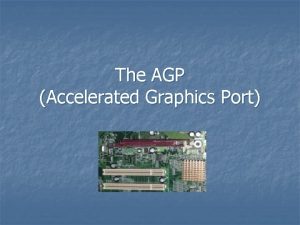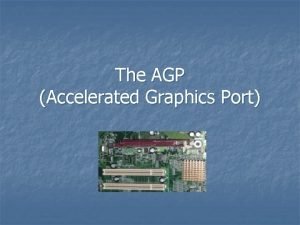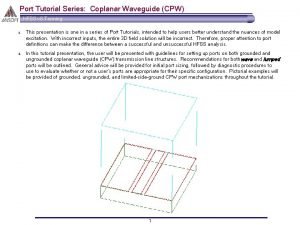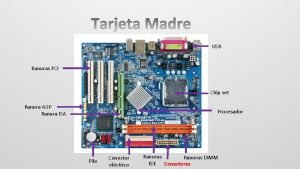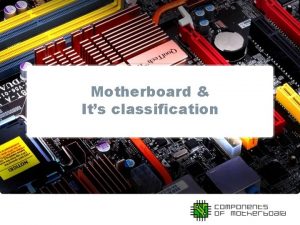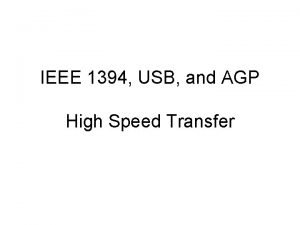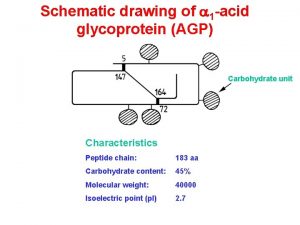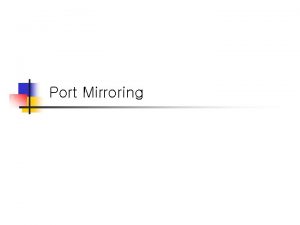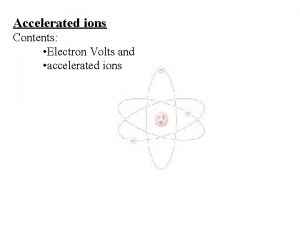The AGP Accelerated Graphics Port PLAN n n



















- Slides: 19

The AGP (Accelerated Graphics Port)

PLAN n n n AGP Difference between PCI and AGP slots Versions of AGP Variations Use today

AGP n The Accelerated Graphics Port (also called Advanced Graphics Port) is a high-speed point-to-point channel for attaching a graphics card to a computer’s motherboard, primarily to assist in the acceleration of 3 D computer graphics.

AGP n Some motherboards have been built with multiple independent AGP slots. AGP is currently being phased out in favor of PCI Express.

Advantages over PCI

Advantages over PCI n For the needs of modern graphics adapters, the AGP bus is superior to PCI because it provides a dedicated pathway between the slot and the processor, allowing for faster communication between the two. AGP also uses sideband addressing, meaning that addressing for packets is carried outside of the packet, so the entire packet does not need to be read to get addressing information.

Advantages over PCI n In addition, to load a texture, a PCI graphics card must copy it from the system's RAM into the card's framebuffer, whereas an AGP card is capable of reading textures directly from system RAM using the Graphics Address Remapping Table (GART).

Versions of AGP n AGP 1 x A 32 -bit channel operating at 66 MHz resulting in a maximum data rate of 266 megabytes per second (MB/s), doubled from the 133 MB/s transfer rate of PCI bus 33 MHz / 32 -bit; 3. 3 V signaling.

Versions of AGP n AGP 2 x A 32 -bit channel operating at 66 MHz double pumped to an effective 133 MHz resulting in a maximum data rate of 533 MB/s; signaling voltages the same as AGP 1 x;

Versions of AGP n AGP 4 x A 32 -bit channel operating at 66 MHz quad pumped to an effective 266 MHz resulting in a maximum data rate of 1066 MB/s (1 GB/s); 1. 5 V signaling;

Versions of AGP n AGP 8 x A 32 -bit channel operating at 66 MHz, strobing eight times per clock, delivering an effective 533 MHz resulting in a maximum data rate of 2133 MB/s (2 GB/s); 0. 8 V signaling.

Versions of AGP n In addition, AGP Pro cards of various types exist. They require more power and are often longer than standard AGP cards (though they only connect to one AGP slot). These cards are usually used to accelerate professional computer-aided design applications employed in the fields of architecture, machining, engineering, simulations, and similar fields. The AGP Pro slot has a few extra pins which supply extra power to the graphics card.

Variations n n 64 bit AGP: A 64 -bit channel. Used in high end professional graphic cards. AGP Express: Not a true AGP interface, but rather a way to allow an AGP card to be connected over the legacy PCI bus on a PCI Express motherboard. An "AGP Express" slot is basically a PCI slot(with the electrical power of two). The performance and the quality of that interface is somewhat questionable. (some AGP cards do not work with AGP Express)

Variations n AGI: The ASRock Graphics Interface (AGI) is a proprietary variant of the Accelerated Graphics Port (AGP) standard. Its purpose is to provide AGP-support for those of Asrock's motherboards that use chipsets lacking native AGP-support.

Variations n AGX: The Epo. X Advanced Graphics e. Xtended (AGX) is also a proprietary variant of the Accelerated Graphics Port (AGP) standard. It shares the same problems with the AGI port explained above. User manuals even recommend not using AGP 8 X ATI cards with AGX slots.

Variations n XGP: The Biostar Xtreme Graphics Port is also a variant of the Accelerated Graphics Port (AGP) standard. It is similar to the two standards above, in that it supports AGP cards with chipsets that do not support AGP. Also like the above, it has support issues with many AGP cards.

Compatibility, AGP Keys on card (top), on slot (bottom)

Use today n As of late 2006, there are few new motherboards being introduced which feature AGP. PCI Express allows much faster data transfer, is full-duplex, and also supports other devices. So far, 2006 has seen many motherboards introduced with PCIe slots, with some gamer-oriented configurations offering dual PCIe x 16 slots. Many newer graphics cards are available exclusively in PCIe, with AGP versions of the same cards becoming correspondingly rare.

CONCLUSION Graphic Animation => before => now ? In the future
 Ranura agp
Ranura agp Accelerated graphics port speed
Accelerated graphics port speed Port agp
Port agp Write the features of mode 0 in 8255
Write the features of mode 0 in 8255 In bsr mode
In bsr mode Hfss coplanar waveguide
Hfss coplanar waveguide Ranura agp
Ranura agp Zocalo agp
Zocalo agp How would you classify the motherboard of a computer?
How would you classify the motherboard of a computer? Agp to usb
Agp to usb Agp full form
Agp full form Gerard thien
Gerard thien Ranura agp
Ranura agp Adresna magistrala
Adresna magistrala Agp drawing
Agp drawing Sabirnica bus
Sabirnica bus Isa industry standard architecture
Isa industry standard architecture Graphics monitors and workstations
Graphics monitors and workstations Dot matrix display ppt
Dot matrix display ppt Plan graphics for the landscape designer
Plan graphics for the landscape designer
